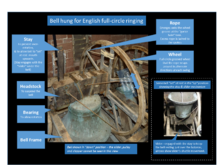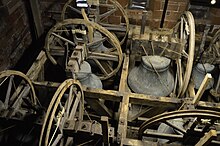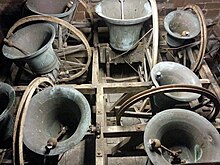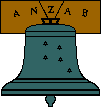This article needs additional citations for verification .(June 2022) |
Full circle ringing is a technique of ringing a tower bell such that it swings in a complete circle from mouth upwards to mouth upwards and then back again repetitively.
This article needs additional citations for verification .(June 2022) |
Full circle ringing is a technique of ringing a tower bell such that it swings in a complete circle from mouth upwards to mouth upwards and then back again repetitively.
Full-circle tower bell ringing in England developed in the early 17th century when bell ringers found that swinging a bell through a much larger arc than that required for swing-chiming gave control over the time between successive strikes of the clapper. A bell swinging through a small arc acts as a simple pendulum, at a time interval governed by its size and shape. By swinging it through a much larger arc approaching a full circle, control of the strike interval can be exercised by the ringer. This culminated in the technique of full circle ringing, which enabled ringers to control the speeds of their individual bells accurately to sound them in orderly sequences. From this was born the art of change ringing.
Speed control is exerted by the ringer only when each bell is nearly mouth upwards and moving slowly near the balance point; this constraint and the rope manipulation involved normally requires that each bell has its own ringer. The tower bells involved range from a few hundredweight up to a few tons [lower-alpha 1] and are most commonly associated with churches as a means of calling the congregation to worship.
Beginning in the mid-1980s, smaller sets of bells, known as "mini-rings", have come into existence. Their primary applications are for training, demonstration or leisure purposes, with bells weighing anything from a matter of ounces, to two-and-a-half hundredweight. [1] Most of these are in domestic settings and are privately owned, although some are owned by churches.




There are several variations of the means of exerting control of the bell by the ringers, but the fundamental principle of being able to control and alter the speed of the bell striking is common to all full circle techniques.
The bell is attached to a headstock, historically made of wood but now more often steel. This has to withstand the dynamic force of the bell as it swings, up to three times its static weight. At each end of the headstock are protruding trunnions or bearing pins which are located in bearings attached to the frame. The frame is rigidly attached to the fabric of the tower.
Within the bell is a clapper which consists of a solid shaft, (wood, iron or steel) a clapper ball (wrought iron or steel) and a flight. The size of the flight determines the rate at which the clapper swings, and therefore the point in time at which it strikes the bell.
Bells are normally left mouth down (for safety). Before ringing, the bells are swung in increasing arcs until the bell is mouth uppermost. When the ringer desires to make a stroke, the bell is swung around a full circle, the clapper striking once.
There is no counter-balancing in English full-circle ringing, so the bell accelerates rapidly to its maximum velocity when mouth downwards and slows down as it rises to mouth upwards. In Veronese full-circle ringing there is a large amount of counter-balancing, so there is little net gravitation pull and the bell accelerates slowly and rotates gracefully. The small out-of-balance weight makes it much easier than English bells to stop the bells mouth upwards. However, English full-circle ringing is capable of much better control of bell speed, as it is independent of the counter-balance effect. The Bolognese style of bell hanging does not have any counter-balancing.
In English full circle ringing "mini-rings" are used to demonstrate how full-circle ringing on large bells works. These rings can be assembled quickly, but the bells are light and the ringing is fast. They demonstrate a difficult concept visually, as both the actions of the ringers and the bells can be seen simultaneously.
The sound made by a bell rung full-circle has two unique subtle features: rapid strike decay and the Doppler effect.
Because the clapper strikes the bell as it rises to the mouth upwards position, it rests against the bell's soundbow after the strike. The peak strike intensity decays away quickly since the clapper helps dissipate the bell's vibration energy. This enables rapid successive strikes of multiple bells, such as in change ringing, without excessive overlap and consequent blurring of successive strikes. In addition, the movement of the bell imparts a Doppler effect to the sound, as the strike occurs whilst the bell is still moving.
Both these effects give full circle ringing of bells in an accurate sequence a distinctive sound which cannot be simulated by stationary chimed bells.
The bells are mounted within a bellframe of steel or wood, and each bell is suspended from a headstock fitted to bearings so that the bell may rotate.
The headstock is fitted with a wooden stay, which, in conjunction with a slider, limits maximum rotational movement to just over a full circle, and allows the bell to be set or rested mouth uppermost. A large wheel is fitted to the headstock, and the rope wraps and unwraps as the bell rotates backwards and forwards. Within the bell is a clapper that strikes the thickest part of the bell mouth called the soundbow. In English, ringing a set of bells is known as a "ring of bells", and an example of a ring of eight bells is shown mouth upwards in the rest position in the accompanying image.
The ringers stand in a ringing chamber below, and the ropes pass through holes in the ceiling. The rope has a woollen grip called the sally while the lower end of the rope is doubled over to form an easily held tail-end.
Bells hung in this fashion gave rise to the invention of English Change ringing in the 17th century because the bells' striking interval could be controlled. There are over 5,000 rings of bells in England, the vast majority in Anglican church towers, and an estimated 40,000 bell ringers.
At East Bergholt England's only bell cage is in the graveyard, where the bells are rung by the ringers standing beside the bells and pulling on the headstock directly, rather like the Bolognese technique described below.
Veronese bells are rung with a wheel and rope but do not have stays. The bells often swing outside the towers and so the clappers are wired in case of breakages. The bells are usually at the top of high towers and are rung from the ground floor, so most of the rope is steel as is the wheel.
The Veronese bellringing art consists of slow moving pieces of music called by a Maestro.
Bolognese-style bells have neither stay nor wheel, but in place of the wheel is an A-frame. Like English bells they are not counter-balanced. The ringers are distributed below and among the bells, pulling on the A-frame either with their hands or by ropes. When the bells are being raised, the ringers may stand on the large wooden headstocks to impart the necessary force.
The Bolognese bell ringing art consists of prearranged methods rung at a rate of change similar to English call changes.

Change ringing is the art of ringing a set of tuned bells in a tightly controlled manner to produce precise variations in their successive striking sequences, known as "changes". This can be by method ringing in which the ringers commit to memory the rules for generating each change, or by call changes, where the ringers are instructed how to generate each change by instructions from a conductor. This creates a form of bell music which cannot be discerned as a conventional melody, but is a series of mathematical sequences. It can also be automated by machinery.

Campanology is the scientific and musical study of bells. It encompasses the technology of bells—how they are founded, tuned and rung—as well as the history, methods, and traditions of bellringing as an art.

A bell is a directly struck idiophone percussion instrument. Most bells have the shape of a hollow cup that when struck vibrates in a single strong strike tone, with its sides forming an efficient resonator. The strike may be made by an internal "clapper" or "uvula", an external hammer, or—in small bells—by a small loose sphere enclosed within the body of the bell.

A church bell is a bell in a church building designed to be heard outside the building. It can be a single bell, or part of a set of bells. Their main function is to call worshippers to the church for a communal service, but are also rung on special occasions such as a wedding, or a funeral service. In some Christian traditions they signify to people outside that a particular part of the service has been reached.
A handbell is a bell designed to be rung by hand. To ring a handbell, a ringer grasps the bell by its slightly flexible handle – traditionally made of leather, but often now made of plastic – and moves the arm to make the hinged clapper strike the inside of the bell. An individual handbell can be used simply as a signal to catch people's attention or summon them together, but handbells are also often heard in tuned sets.

The Ellacombe apparatus is a mechanism devised for performing change ringing on church bells by striking stationary bells with hammers. It does not produce the same sound as full circle ringing due to the absence of Doppler effect as the bells do not rotate, and the lack of a damping effect from the clapper after each strike.
The Pummerin ("boomer") or Marienglocke is the largest bell in the Stephansdom, St. Stephen's Cathedral, in Vienna.

Russian Orthodox bell ringing has a history starting from the baptism of Rus in 988 and plays an important role in the traditions of the Russian Orthodox Church.

A "ring of bells" is the name bell ringers give to a set of bells hung for English full circle ringing. The term "peal of bells" is often used, though peal also refers to a change ringing performance of more than about 5,000 changes.

In campanology, a peal is the special name given to a specific type of performance of change ringing which meets certain exacting conditions for duration, complexity and quality.

The funeral tolling of a bell is the technique of sounding a single bell very slowly, with a significant gap between strikes. It is used to mark the death of a person at a funeral or burial service.

A bell-ringer is a person who rings a bell, usually a church bell, by means of a rope or other mechanism.
Bolognese bell ringing is a tradition of ringing bells that developed in Bologna, present day Italy. A form of full circle ringing, it entails swinging bells to develop rhythmic patterns.
A death knell is the ringing of a church bell to announce the death of a person. Historically, it was the second of three bells rung around death, the first being the passing bell to warn of impending death, and the last was the lych bell or corpse bell, which survives today as the funeral toll.

Veronese bell ringing is a style of ringing church bells that developed around Verona, Italy, from the eighteenth century. The bells are rung full circle, being held up by a rope and wheel until a note is required.

The Lullusglocke is the oldest datable cast bell in Germany. The inscription indicates it was cast on 24 June 1038. It hangs in the Catherine Tower in the ruins of the monastery of Bad Hersfeld in Hesse.

The Australian and New Zealand Association of Bellringers, known as ANZAB, is the organisation responsible for the promotion of English-style "full circle ringing" – namely change ringing and method ringing in bell towers with a peal of bells – across Australia and New Zealand.

The Duke's Tower, also known as Inveraray Bell Tower, is the detached bell tower of All Saints' Church, Inveraray, Argyll and Bute, Scotland. Standing 126 feet (38 m) high on the shores of Loch Fyne, it is a landmark for miles and amongst the most notable bell towers in the United Kingdom. The tower was built as a memorial to members of the Clan Campbell who died in the First World War. It is Category A listed by Historic Environment Scotland, the highest possible rating.
Campanology is the scientific and musical study of bells. It encompasses the technology of bells – how they are cast, tuned, and rung – as well as the history, methods, and traditions of bellringing as an art. Articles related to campanology include: